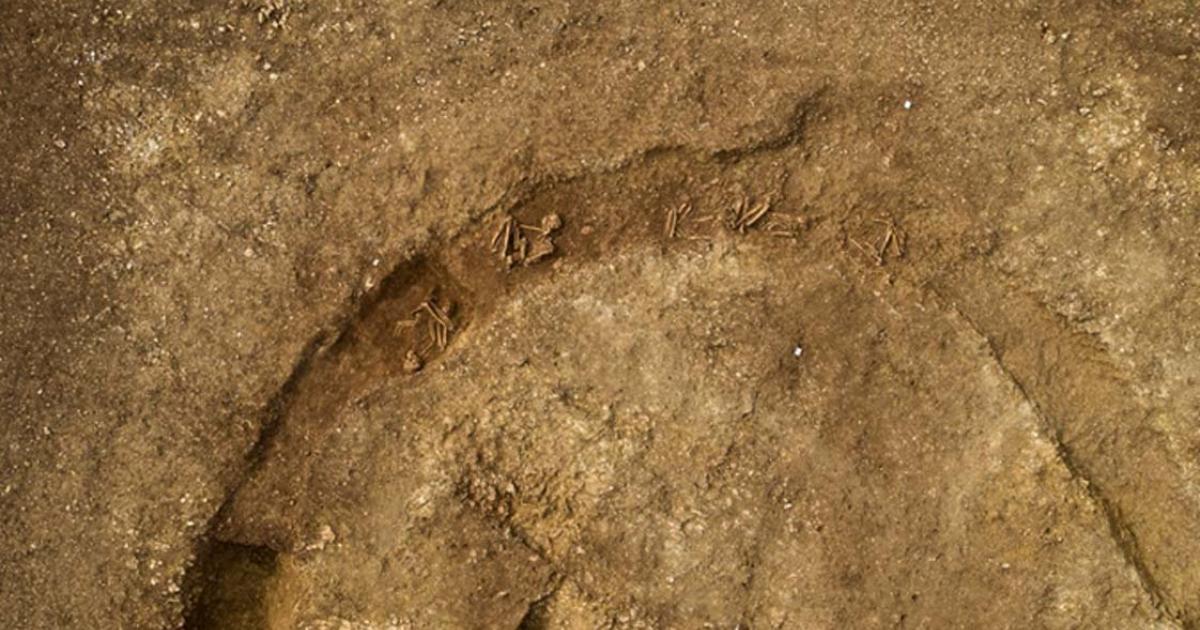
Archaeologists Discover a Stone Age “Cult” Henge Site and 4,000 Year-old Human Remains
A team of archaeologists has discovered a Stone Age “cult” henge site and human remains that are estimated to be nearly 4,000 years old. Experts suggest that the human remains, found near Stratford, could belong to some of south Warwickshire’s earliest residents.
Henge was Most Likely Used for Rituals
A group of archaeologists recently discovered a Stone Age “cult” henge site and ancient human remains at a real estate development of residential buildings in Newbold-on-Stour, on fields at Mansell Farm in Stratford. Unlike Stonehenge, the newly found henge is a plain design consisting of a ditch dug into segments and a bank made up of material thrown up from the ditch.
Archaeology Warwickshire Business Manager Stuart Palmer couldn’t hide his excitement about the discovery and stated as Stratford Observer reports, “This exciting discovery is of national importance as it provides tangible evidence for cult or religious belief in late Stone Age Warwickshire. Amazingly it is the second such find by the team. In 2015 a group of four henges was excavated in Bidford although the burials at this site were all cremated. Prior to this there were no known henges in Warwickshire leading some archaeologists to believe that a different kind of cult was prevalent in the region.”

Excavations at Mansell Farm, Newbold-on-Stour (Credit: Archaeology Warwickshire)
- Stonehenge and Nearby Stone Circles Were Newcomers to Landscape worked by Ice Age hunters
- The Sacred Prehistoric Neolithic Complex of the Thornborough Henges
- Major Discovery: 4,500-year-old megalithic super-henge found buried one mile from Stonehenge
Furthermore, archaeology Warwickshire Project Officer Nigel Page, who excavated the site added as Stratford Observer always reports, “Exactly what the henge was used for is not certain, but it is likely to be have been used for rituals, some of which may have been associated with cosmological events over 4000 years ago. Originally it would have been surrounded by a bank which would probably have been on the outside of the ditch. Unlike other types of site the ditch and bank were not for defense, but were intended to close off the interior of the henge and make it an arena for whatever festivals or rituals were taking place within.”
Human Remains Could Belong to the Earliest Residents of South Warwickshire
As we already mentioned, the findings also included the buried remains of five individuals which survived as complete skeletons, a very peculiar and unusual phenomenon for the area, archaeologists stated. The individuals were buried very carefully as none of the bodies was found to be positioned on top of another. Experts suggest that the buried individuals could be some of the earliest residents in the area and they estimate that the remains are ancient, somewhere around 4,000 years old. Nigel Page tells Stratford Observer “The rare survival of the skeletons will provide an important opportunity to gain a unique insight into the lives of the people who not only knew the henge and its landscape, but who were probably some of the region’s earliest residents”.

Henge burial detail (Credit: Archaeology Warwickshire)
The three middle burials were facing west, out from the henge, while the two in the two opposite corners were facing east, into the henge. The seemingly calculated positioning of the bodies, indicates that the buried individuals possibly belonged to the same group (most likely were members of the same family), while the people who buried them obviously knew that the grave was owned by the specific group or family.
- Ancient Ceremonial Site 10 Times Bigger than Stonehenge Hits the Archaeological Spotlight
- The Missing Link to Stonehenge: Stone Age Eco-Home Discovered near Famous Monument
- 5,600-Year-Old Ceremonial Center Found Near Stonehenge, Built 1,000 Years Before Stone Circle was Erected
Further Analysis and Examination Will Reveal More Information
The skeletons have now been unearthed from the site and researchers are getting ready to conduct detailed testing and further analysis, in order to discover more details about who those individuals were.
Nigel Page told Stratford Observer, “The skeletons have been recovered from the site and will undergo scientific analysis to try to answer the many questions that their presence on the site has raised. For example, it is hoped that the sex and age of the people can be established and it may also be possible to determine if there was a family connection between them,” clearly implying that there's more to come from this intriguing discovery.
Top image: Aerial view of circular henge remains and burials (Credit: Archaeology Warwickshire)















